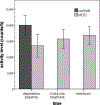An Examination of Psychomotor Disturbance in Current and Remitted MDD: An RDoC Study
- PMID: 32467859
- PMCID: PMC7255437
- DOI: 10.20900/jpbs.20200007
An Examination of Psychomotor Disturbance in Current and Remitted MDD: An RDoC Study
Abstract
Major depressive disorder (MDD) is a serious public health problem that has, at best, modest treatment response-potentially due to its heterogeneous clinical presentation. One way to parse the heterogeneity is to investigate the role of particular features of MDD, an endeavor that can also help identify novel and focal targets for treatment and prevention efforts. Our R01 focuses on the feature of psychomotor disturbance (e.g., psychomotor agitation (PmA) and retardation (PmR)), a particularly pernicious feature of MDD, that has not been examined extensively in MDD. Aim 1 is comparing three groups of individuals-those with current MDD (n = 100), remitted MDD (n = 100), and controls (n = 50)-on multiple measures of PmR and PmA (assessed both in the lab and in the subjects' natural environment). Aim 2 is examining the structural (diffusion MRI) and functional (resting state fMRI) connectivity of motor circuitry of the three groups as well as the relation between motor circuitry and the proposed indicators of PmR and PmA. Aim 3 is following up with subjects three times over 18 months to evaluate whether motor symptoms change in tandem with overall depressive symptoms and functioning over time and/or whether baseline PmR/PmA predicts course of depression and functioning. Aim 3 is particularly clinically significant. Finding that motor functioning and overall depression severity co-vary over time, or that motor variables predict subsequent change in overall depression severity, would support the potential clinical utility of these novel, reliable, and easily administered motor assessments.
Keywords: major depressive disorder; psychomotor agitation; psychomotor retardation; remitted depression.
Conflict of interest statement
CONFLICTS OF INTEREST The authors declare that they have no conflicts of interest.
Figures





References
-
- Ustün TB, Ayuso-Mateos JL, Chatterji S, Mathers C, Murray CJL. Global burden of depressive disorders in the year 2000. Br J Psychiatry. 2004;184:386–92. - PubMed
-
- Konnopka A, Leichsenring F, Leibing E, König H-H. Cost-of-illness studies and cost-effectiveness analyses in anxiety disorders: a systematic review. J Affective Disord. 2009;114(1–3):14–31. - PubMed
-
- Collins KA, Westra HA, Dozois DJ, Burns DD. Gaps in accessing treatment for anxiety and depression: Challenges for the delivery of care. Clin Psychol Rev. 2004;24(5):583–616. - PubMed
-
- Tolin DF. Is cognitive-behavioral therapy more effective than other therapies? A meta-analytic review. Clin Psychol Rev. 2010;30(6):710–20. - PubMed
-
- Shankman SA, Gorka SM, Katz AC, Klein DN, Markowitz JC, Arnow BA, et al. Side effects to antidepressant treatment in patients with depression and comorbid panic disorder. J Clin Psychiatry. 2017;78(4):433–40. - PubMed
Grants and funding
LinkOut - more resources
Full Text Sources
Miscellaneous
